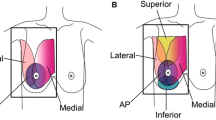Abstract
Purpose
The aims of this study were to investigate the visualization rate for the mammary gland under the nipple with automated breast ultrasonography (US) and to compare the detectability of breast lesions under the nipple with automated breast imaging and handheld US imaging.
Materials and methods
A total of 60 patients underwent automated breast US (ABVS; Siemens Medical Solutions, Mountain View, CA, USA) and handheld US. The scans of the four segments of the breast included sequential scans in the upper-outer (C), lower-outer (D), lowerinner (B), and upper-inner (A) regions.
Results
The visualization rates for the mammary gland under the nipple were 72% (86/120 breasts) in A-scanning, 84% (101/120) in B-scanning, 78% (93/120) in C-scanning, and 80% (96/120) in D-scanning. Interscanning mode differences were statistically significant only for A-scanning and B-scanning (P = 0.02). Eventually, 98% (117/120 breasts) of the breasts examined were rated as “visualized.” In 14 of the 15 patients with breast lesions under the nipple, the lesions were detectable with handheld US and the ABVS. In the other patient, the lesion was not detectable on handheld US but was detected on ABVS imaging.
Conclusion
ABVS imaging is by no means inferior to handheld US for detecting breast lesions under the nipple.
Similar content being viewed by others
References
Stavros AT, Thickman D, Rapp CL, Dennis MA, Parker SH, Sisney GA. Solid breast nodules: use of sonography to distinguish between benign and malignant lesions. Radiology 1995;196:123–134.
Zonderland HM, Coerkamp EG, Hermans J, van de Vijver MJ, van Voorthuisen AE. Diagnosis of breast cancer: contribution of US as an adjunct to mammography. Radiology 1999;213: 413–422.
Flobbe K, Nelemans PJ, Kessels AG, Beets GL, von Meyenfeldt MF, van Engelshoven JM. The role of ultrasonography as an adjunct to mammography in the detection of breast cancer: a systematic review. Eur J Cancer 2002;38:1044–1050.
Cosgrove DO, Kedar RP, Bamber JC, al-Murrani B, Davey JB, Fisher C, et al. Breast diseases: color Doppler US in differential diagnosis. Radiology 1993;189:99–104.
Raza S, Baum JK. Solid breast lesions: evaluation with power Doppler US. Radiology 1997;203:164–168.
Itoh A, Ueno E, Tohno E, Kamma H, Takahashi H, Shiina T, et al. Breast disease: clinical application of US elastography for diagnosis. Radiology 2006;239:341–350.
Tozaki M, Isobe S, Yamaguchi M, Ogawa Y, Kohara M, Joo C, et al. Optimal scanning technique to cover the whole breast using an automated breast volume scanner. Jpn J Radiol 2010;28:325–328.
Author information
Authors and Affiliations
Corresponding author
About this article
Cite this article
Isobe, S., Tozaki, M., Yamaguchi, M. et al. Detectability of breast lesions under the nipple using an automated breast volume scanner: comparison with handheld ultrasonography. Jpn J Radiol 29, 361–365 (2011). https://doi.org/10.1007/s11604-010-0555-5
Received:
Accepted:
Published:
Issue Date:
DOI: https://doi.org/10.1007/s11604-010-0555-5




